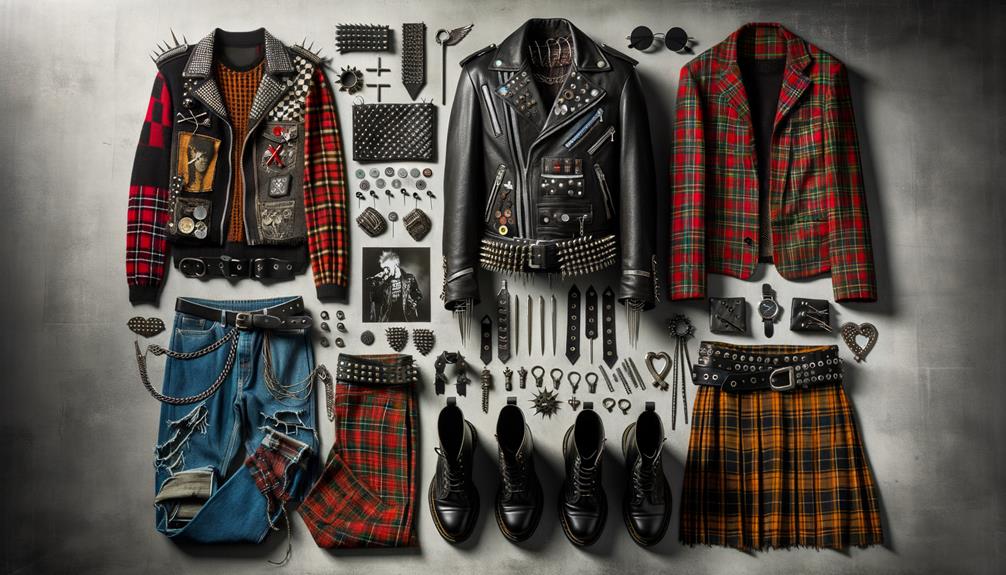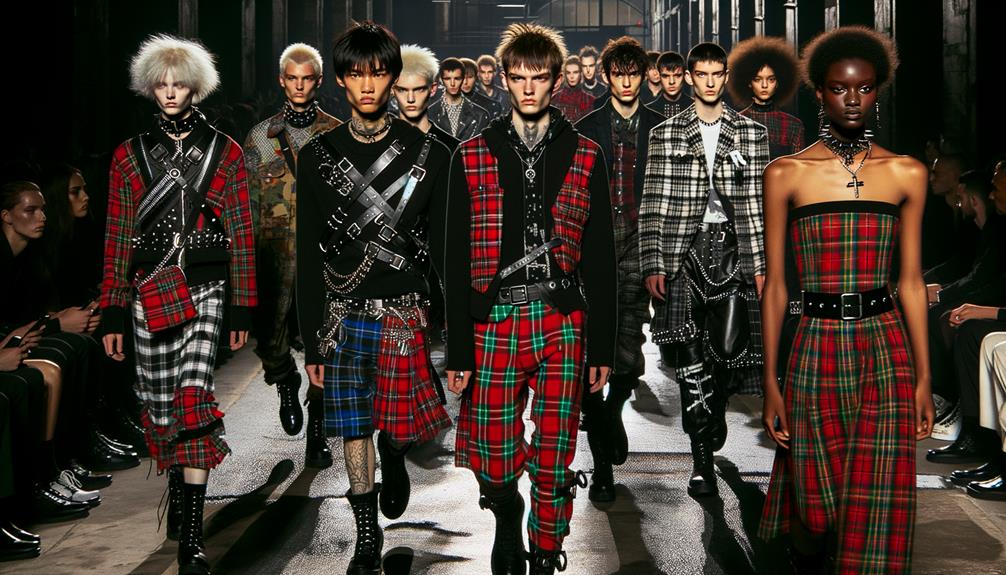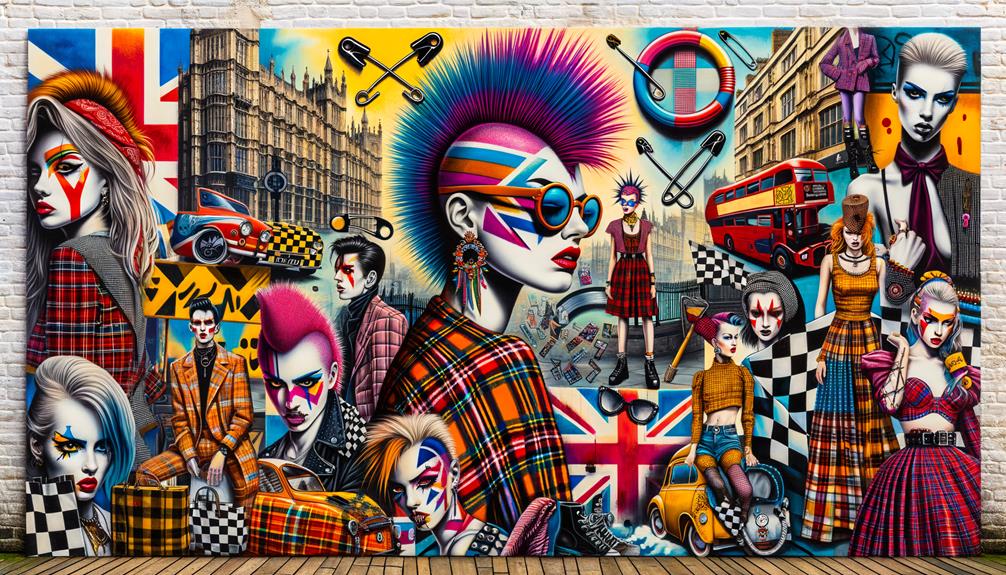Vivienne Westwood was a true punk pioneer, defying convention with her radical designs at Seditionaries. Her iconic bondage trousers and rubber dresses didn't just push boundaries – they shattered them. By merging Teddy Boy subculture with fetish influences, Westwood created an explosive blend that screamed rebellion. Her designs weren't just about fashion's superficiality; she infused her creations with social causes, making statements that went beyond the fabric. Westwood's legacy continues to inspire new generations, championing sustainability and leaving a lasting impact. To grasp the full impact of her visionary genius, you need to explore the depth of her influence.
Early Punk Influence
In the early days of punk, Vivienne Westwood's radical designs didn't just push boundaries – they destroyed them. Her work at the Seditionaries boutique on Kings Road, in collaboration with Malcolm McLaren, became a hub for the punk movement. These designs weren't just clothes; they were declarations of rebellion. Each piece screamed defiance, challenging societal norms with an edgy, abrasive flair.
I recall how Westwood's handmade fetish clothing, blending Teddy Boy subculture and fetishist influences, became the fabric of punk ethos. Her creations were provocative, designed to shock and awe, but they carried an undercurrent of authenticity and raw energy. By rejecting traditional fashion norms, she critiqued modern punk's credibility, prioritizing substance over superficiality.
Vivienne Westwood's early influence extended beyond fashion; she laid the groundwork for a movement that questioned everything. Her foresight in intertwining social causes with style also planted the seeds for sustainable fashion. Westwood's legacy isn't just in the stitches and fabric but in the enduring spirit of rebellion and innovation she ignited.
Iconic Punk Designs

Vivienne Westwood's iconic punk designs, like bondage trousers and rubber dresses, didn't just adorn the body – they made a bold statement that resonated with the rebellious heart of the punk movement. These creations were more than fashion; they were a raw, unfiltered expression of defiance. When I think of her stilettos with spikes, they epitomize the perfect blend of aggression and style that defined punk's core ethos.
Her collaboration with Malcolm McLaren and the influence of the Sex Pistols brought her rebellious vision to life. Westwood's designs, featuring offensive imagery and provocative elements, weren't mere provocations; they were a scathing critique of societal norms and expectations. Her work can be summarized in three pivotal ways:
- Disruption: The bondage trousers and rubber dresses challenged traditional aesthetics and shook up the fashion industry.
- Provocation: The offensive imagery and provocative elements in her designs forced society to confront its taboos head-on.
- Innovation: Despite criticism, her creations gained commercial success and industry approval, proving that true innovation often lies on the fringes.
Westwood's shift from punk to historical costume later, with collections like Pirate and Buffalo Girls/Nostalgia for Mud, showcased her remarkable versatility. Yet, her punk designs remain etched in the annals of fashion history.
Collaborations and Partnerships

Partnering with Malcolm McLaren, I felt the raw energy and rebellious spirit of punk come alive in ways I never imagined. Together, we crafted provocative and edgy designs that became the very essence of punk fashion. Our collaborations were a blend of chaos and creativity, each piece a reflection of our boundary-pushing ethos.
After my split from Malcolm, I found a new partnership with Carlo D'Amario. His business acumen allowed my eponymous line to flourish, reaching new heights of global recognition. Our collaboration was less about rebellion and more about refining the innovative designs that had become my signature.
My most enduring collaboration, though, has been with Andreas Kronthaler, my husband. Andreas took over the Gold Label line, ensuring that our brand continually evolved. His fresh perspective and daring approach have kept our designs innovative and relevant.
Throughout my career, I've sought out collaborations with various artists and designers, each bringing a unique voice to my work. These partnerships have been pivotal, allowing me to consistently push the boundaries of fashion. Together, we've created a legacy of transformative, provocative, and globally recognized designs.
Legacy in Modern Fashion

Reflecting on my numerous collaborations, I see how each partnership shaped my legacy in modern fashion, particularly through the punk movement that defied traditional norms and embraced rebellion. My work with Malcolm McLaren was a turning point, propelling a revolution that forever altered the fashion landscape. This partnership taught me the power of challenging traditional fashion norms, embedding a rebellious aesthetic into the fabric of my designs.
Three key elements have been instrumental in shaping my legacy:
- Boundary-pushing designs: Each piece I created served as a statement, pushing the limits of what fashion could express.
- Socially conscious engagement: My activism infused my designs with meaning, merging social awareness with sartorial expression.
- Lasting influence: The rebellious spirit of punk continues to inspire generations of designers, cementing my status as a fashion icon.
My legacy is not just stitched into the garments but woven into the ethos of modern fashion. The daring spirit that drove my initial steps has left an indelible mark, encouraging others to innovate and challenge the status quo. As I look back, I see a tapestry of influence that spans decades, forever altering how we perceive fashion.
In essence, my legacy is about more than just the clothes; it's about the attitude and spirit that defines modern fashion.
Cultural Impact

Through the punk lens, I saw fashion evolve into a powerful cultural force that challenged societal norms and sparked crucial conversations. Vivienne Westwood's punk designs, with their provocative imagery and edgy aesthetics, transcended mere clothing; they made bold statements. Each piece became a symbol of anti-authoritarianism, pushing boundaries and confronting the status quo head-on.
Her collaborations with Malcolm McLaren and the Sex Pistols didn't just revolutionize fashion; they ignited a movement. Westwood's activism on environmental issues and civil liberties infused her work with deeper meaning. She wasn't simply creating fashion; she was advocating for social causes, embedding her garments with messages that resonated with a disenchanted youth craving change.
Westwood's commitment to sustainable fashion practices underscored her forward-thinking ethos. By championing eco-friendly materials and methods, she inspired a generation of designers to contemplate the environmental impact of their creations. Her influence seeped into contemporary fashion trends, encouraging a blend of style and substance.
In essence, Westwood's cultural impact lies in her ability to merge punk's rebellious spirit with a profound sense of purpose, making her a leader for those who seek innovation and social justice through fashion.
Frequently Asked Questions
Who Was Vivienne Westwood Influenced By?
I was shaped by the punk rock movement, the DIY ethic of the 1970s, Teddy Boy subculture, fetish fashion, historical costumes, and traditional English tailoring. Working with Malcolm McLaren and designing for the Sex Pistols influenced my rebellious style.
Why Does Gen Z Love Vivienne Westwood?
Gen Z loves Vivienne Westwood because she embodies the spirit of rebellion, sustainability, and iconic style. Her fearless activism and unapologetic attitude resonate deeply with our values, making her a timeless inspiration and a beloved figure for our generation.


